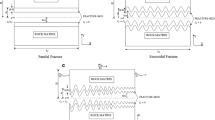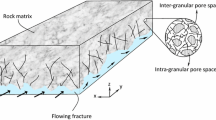Abstract
A numerical model is developed to simulate the colloid-facilitated transport of radionuclides in a single fracture-host rock coupled system with planar geometry. Such a system may be encountered in case of leaching and transport of radionuclides from a high-level radioactive waste repository in deep geological formations. The presence of colloids in the system reduces the retardation effects on the radionuclide migration and can change the concentration distribution of radionuclides in the system significantly. The processes such as advection, dispersion, surface sorption, radioactive decay and diffusive loss to the host rock are considered for transport in the fracture, whereas dispersion, adsorption and radioactive decay are included for transport in the host rock. Since the radionuclides to be disposed into the high-level waste repository may include a decay chain of progeny, the performance assessment methodology must incorporate the ingrowth of progeny with time to carry out realistic estimates. The inclusion of decay chain buildup and transport is essential to avoid underestimation with respect to the environmental impact assessment for the repository. Hence, the numerical model based on implicit finite difference scheme is developed with the inclusion of decay chain transport. The model is verified by comparing with well-known analytical solutions. The application of the model is demonstrated by applying it to a five-member decay chain of 238U. With increase in the concentration of colloids, the concentrations of the radionuclides in the fracture water increase and also reach the steady state at an earlier time. The concentrations of radionuclides almost become steady throughout the distance of 200 m in the fracture as the colloid concentration reaches 5 kg m−3 or more. Sensitivity analysis is carried out with respect to various model parameters such as dispersion coefficient in fracture, dispersion coefficient in the porous host rock, porosity of the host rock and distribution coefficient of radionuclide with respect to the mobile colloids. The developed model can be a useful tool for the performance assessment of high-level radioactive waste repositories.














Similar content being viewed by others
References
Ahn J (1988) Mass transfer and transport of radionuclides in fractured porous rock. Lawarence Berkeley Lab. Publ. LBL-25594
Allard T (2009) Radiation effects on clay mineral properties. Appl Clay Sci 43:143–149
Avogadre A, De Marsily G (1984) The role of colloids in nuclear waste disposal. Mat Res Soc Symp Proc 26:495–505
Baek I, Pitt WW Jr (1996) Colloid-facilitated radionuclide transport in fractured porous rock. Waste Manag 16:313–325
Bagalkot N, Kumar GS (2015a) Effect of nonlinear sorption on multispecies radionuclide transport in a coupled fracture–matrix system with variable fracture aperture: a numerical study. J Hydraul Eng 21:242–254
Bagalkot N, Kumar GS (2015b) Numerical modeling of two species radionuclide transport in a single fracture matrix system with variable fracture aperture. Geosci J. doi:10.1007/s12303-015-0006-5
Bateman H (1910) Solution of a system of differential equations occurring in the theory of radio-active transformations. Proc Camb Philos Soc 15:423–427
Bates M, Bradley JP, Teetsov A, Bradley CR, Buchholtz ten Brick H (1992) Colloid formation during waste form reaction: implications for nuclear waste disposal. Science 256:649–651
Bauer P, Attinger S, Kinzelbach W (2001) Transport of a decay chain in homogenous porous media: analytical solutions. J Contam Hydrol 49:217–239
Buddemeier RW, Hunt JR (1998) Transport of colloidal contaminants in groundwater: radionuclide migration at the Nevada Test Site. Appl Geochem 3:535–548
Cadini F, Bertoli I, Sanctis JD, Zio E (2012) A novel particle tracking scheme for modeling contaminant transport in a dual-continua fractured medium. Water Resour Res 48(10):W10517. doi:10.1029/2011WR011694
Caputo M (1999) Diffusion of fluids in porous media with memory. Geothermics 28:113–130
Cetnar J (2006) General solution of Bateman equations for nuclear transmutations. Ann Nucl Energy 33:640–645
Champ DR, Young JL, Robertson DE, Aber KM (1984) Chemical speciation of long-lived radionuclides in a shallow groundwater flow system. Water Pollut Res J Can 19:35–54
Chen CT, Li SH (1997) Radionuclide transport in fractured porous media-analytical solution for a system of parallel fractures with a constant inlet flux. Waste Manag 17:53–64
Cormenzana J (2000) Transport of a two-member decay chain in a single fracture: simplified analytical solution for two radionuclides with the same transport properties. Water Resour Res 36:1339–1346
Cvetkovic C, Frampton A (2009) Transport and retention from single to multiple fractures in crystalline rock at Aspo (Sweden): 2. Fracture network simulations and generic retention model. Water Resour Res 46(5):W05506. doi:10.1029/2009WR008030
Cvetkovic C, Frampton A (2012) Solute transport and retention in three-dimensional fracture networks. Water Resour Res 48(2):W02509. doi:10.1029/2011WR011086
Cvetkovic V, Painter S, Outters N, Selroos JO (2004a) Stochastic simulation of radionuclide migration in discretely fractured rock near the Aspo Hard Rock Laboratory. Water Resour Res 40(2):W02404. doi:10.1029/2003WR002655
Cvetkovic V, Painter S, Turner D, Pickett D, Bertetti P (2004b) Parameter and model sensitivities for colloid-facilitated radionuclide transport on the field scale. Water Resour Res 40(6):W06504. doi:10.1029/2004WR003048
da Silveira CS, Alvim ACM, Oliva JJR (2013) Radionuclide transport in fractured rock: numerical assessment for high level waste repository. Sci Technol Nucl Install 827961:1–17
Di Giuseppe E, Moroni M, Caputo M (2010) Flux in porous media with memory: models and experiments. Transp Porous Media 83:479–500
Falck WE, Nilsson KF (2009) Geological disposal of radioactive waste, Scientific and Technical Research Series
Freeze RA, Cherry JA (1979) Groundwater. Prentice hall, Englewood Cliffs
Giacobbo F, Patelli E (2008) Monte Carlo simulation of radionuclide transport through fractured media. Ann Nucl Energy 35:1732–1740
Giusti L (2009) A review of waste management practices and their impact on human health. Waste Manag 29(8):2227–2239
Grisak GE, Pickens JF (1980) Solute transport through fractured media, 1. The effect of matrix diffusion. Water Resour Res 16:719–730
Hatch LP (1953) Ultimate disposal of radioactive wastes. Am Sci 41(3):410–421
IAEA (1993) Report on radioactive waste disposal. Technical Report Series No. 349, International Atomic Energy Agency, Vienna
ICRP (1995) Age-dependent doses to the members of the public from intake of radionuclides—part 5 compilation of ingestion and inhalation coefficients. ICRP Publication 72. Ann. ICRP 26 (1)
Jen C, Li S (2001) Migration of radionuclides in porous rock in the presence of colloids: effects of kinetic interactions. Waste Manag 21:569–579
Kretzschmar R, Brokovec M, Grolimund D, Elimelech M (1999) Mobile subsurface colloids and their role in contaminant transport. Adv Agron 66:121–194
Krishnamoorthy TM, Nair RN, Sarma TP (1992) Migration of radionuclides from a granite repository. Water Resour Res 28:1927–1934
Kumar GS (2008) Effect of sorption intensities on dispersivity and macro-dispersion coefficient in a single fracture with matrix diffusion. Hydrogeol J 16:235–249
Kurosawa S, Ueta S (2001) Effect of colloids on radionuclide migration for performance assessment of HLW disposal in Japan. Pure Appl Chem 73:2027–2037
Lee CH, Teng SP (1993) An analytical model for radionuclide transport in a single fracture considering nonequilibrium matrix. Nucl Technol 101:67–78
Li S, Chiou S (1993) Radionuclide migration in fractured porous rock: analytical solution for a kinetic solubility limited dissolution model. Nucl Technol 104:258–271
Li S, Yang H, Jen C (2004) Modeling of colloid transport mechanisms facilitating migration of radionuclides in fractured media. Nucl Technol 148:358–368
Liu C, Yeh H (2003) Radionuclide transport in a multiple and parallel fractured system. Nucl Technol 143:322–334
McDowell-Boyer LM, Hunt JR, Sitar N (1986) Particle transport through porous media. Water Resour Res 22:1901–1921
Moreno L, Rasmuson A (1986) Contaminant transport through a fractured porous rock: impact of the inlet boundary condition on the concentration profile in the rock. Water Resour Res 22:1728–1730
Moreno L, Tsang YW, Tsang CF, Hale F, Neretnieks I (1988) Flow and transport in a single fracture: a stochastic model and its relation with field observations. Water Resour Res 24:2033–2048
Moridis GJ (2002) Semianalytical solutions of radioactive or reactive solute transport in variably fractured layered media. Water Resour Res 38(12):46/1–46/24
Nair RN, Krishnamoorthy TM (1995) Migration of radionuclides from a deep geological repository: analytical model with radial diffusion in host matrix. Nucl Geophys 9:219–228
Nair RN, Krishnamoorthy TM (1997) A simple model for the preliminary safety analysis of a high level radioactive waste repository. Ann Nucl Energy 24:995–1003
Nair RN, Sastry VN (2001) Safety assessment methodologies for near surface radioactive waste disposal facilities. Radiat Prot Environ 24:544–563
Nair RN, Sunny F, Manikandan ST (2010) Modelling of decay chain transport in groundwater from uranium tailings pond. Appl Math Model 34:2300–2311
NAS/NRC (1957) The disposal of radioactive waste on land. Report of the committee on waste disposal, division of earth sciences, Publication 519, National Academy of Sciences/National Research Council Washington, DC, USA
Natarajan N, Kumar GS (2010a) Solute transport in a coupled fracture–matrix system with sinusoidal fracture geometry. Int J Energy Sci Technol 2:1886–1892
Natarajan N, Kumar GS (2010b) Numerical modeling of solute transport in a coupled sinusoidal fracture matrix system in the presence of fracture skin. Int J Energy Environ 4:99–104
Natarajan N, Kumar GS (2010c) Radionuclide and colloid co-transport in a coupled fracture–skin–matrix system. Colloid Surf A Physicochem Eng Asp 370:49–57
Natarajan N, Kumar GS (2011) Spatial moment analysis of colloid facilitated radionuclide transport in a coupled fracture matrix system. Int J Energy Environ Econ 2:491–504
NEA (1999) Geological disposal of radioactive waste, review of developments in the last decade. Nuclear Energy Agency, Organization for Economic Co-operation and Development, Paris
Neretnieks I (1980) Diffusion in the rock matrix: an important factor in radionuclide migration? J Geophys Res 85:4379–4397
Painter S, Cvetkovic C (2005) Up scaling discrete fracture network simulations: an alternative to continuum transport models. Water Resour Res 41(2):W02002. doi:10.1029/2004WR003682
Pickett DA, Dam WL (2005) Approach to assessing the potential effects of colloidal radionuclide transport on nuclear waste repository performance. Nucl Sci Eng 151:114–120
Puls RW (1990) Colloidal considerations in groundwater sampling and contaminant transport predictions. Nucl Saf 31:58–65
Puls RW, Powell RM (1992) Transport of inorganic colloids through natural aquifer material: implications for contaminant transport. Environ Sci Technol 26:614–621
Rasmuson A, Neretnieks I (1981) Migration of radionuclides in fissured rock: the influence of micropore diffusion and longitudinal dispersion. J Geophys Res 86:3749–3758
Schwartz MO (2009) Modelling groundwater contamination above the Asse 2 medium-level nuclear waste repository, Germany. Environ Earth Sci 59:277–286
Sudicky EA (1989) The Laplace transform Galerkin technique: a time-continuous finite element theory and application to mass transport in groundwater. Water Resour Res 25:1833–1846
Sudicky EA, Frind EO (1982) Contaminant transport in fractured porous media: analytical solution for a system of parallel fractures. Water Resour Res 18:1634–1642
Sudicky EA, Frind EO (1984) Contaminant transport in fractured porous media: analytical solution for a two member decay chain in a single fracture. Water Resour Res 20:1021–1029
Sun Y, Buscheck TA (2003) Analytical solutions for reactive transport of N-member radionuclide chains in a single fracture. J Contam Hydrol 62–63:695–712
Tang DH, Frind EO, Sudicky EA (1981) Contaminant transport in fractured porous media: analytical solution for a single fracture. Water Resour Res 17:555–564
Travis BJ, Nuttal HE (1985) Analysis of colloid transport. Sci Basis Nucl Waste Manag VIII(50):737–745
Tsang YW, Tsang CF, Neretnieks I, Moreno L (1988) Flow and transport through fractured media: a variable-aperture channel model and its properties. Water Resour Res 24:2049–2060
USNRC (1983) A study of the isolation system for geologic disposal of radioactive wastes. National Academy Press, Washington, D C
Witherspoon PA, Bodvarsson GS (2001) Geological challenges in radioactive waste isolation. Third worldwide review, Report LBNL-49767, Berkeley, CA 94720, USA: Lawrence Berkeley National Laboratory
Acknowledgments
The authors would like to thank Dr. K. S. Pradeepkumar of Bhabha Atomic Research Centre (BARC), Mumbai, India, for his encouragement and support during the study.
Author information
Authors and Affiliations
Corresponding author
Rights and permissions
About this article
Cite this article
Chopra, M., Sunny, F. & Oza, R.B. Numerical modeling of colloid-facilitated radionuclide decay chain transport in a coupled fracture–matrix system. Environ Earth Sci 75, 1300 (2016). https://doi.org/10.1007/s12665-016-6105-4
Received:
Accepted:
Published:
DOI: https://doi.org/10.1007/s12665-016-6105-4




